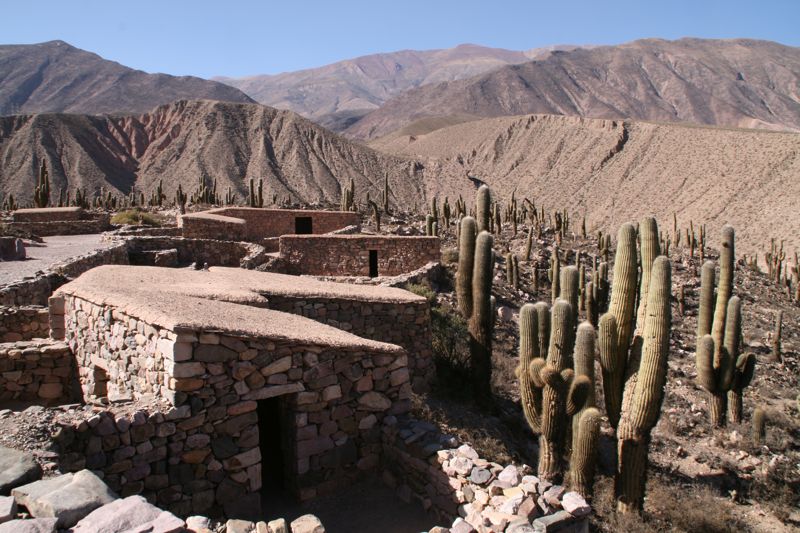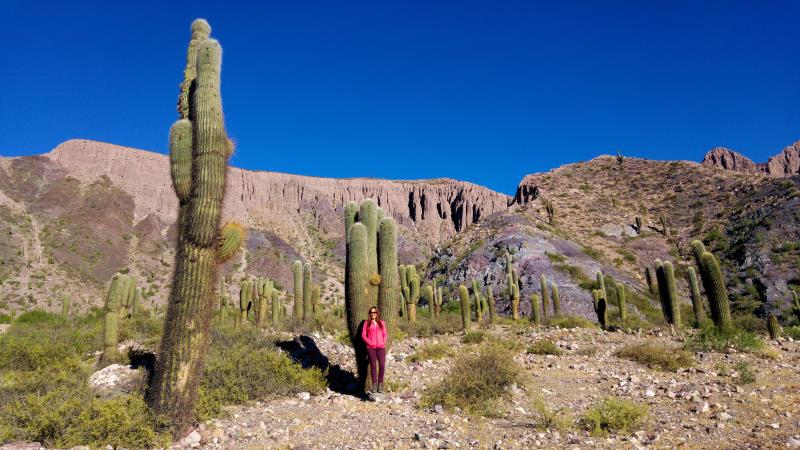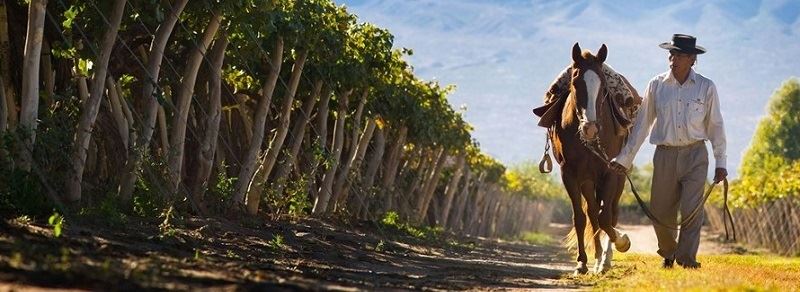Complete North West Argentina: 10 days
Day 1: Salta to Tilcara: we take the windy mountain road to San Salvador de Jujuy, a taste of the verdant sub-tropical forest to the east of the Andes mountain range: and climb into the Quebrada de Humahuaca. Highlights here, aside from the great multi-coloured scenery, include colonial churches (the one at Uquia has some rare artwork), pre-Inca ruins at Tilcara, and a Spanish fort now converted into a museum dedicated to the War of Independence, much of which was fought here. We can also visit some of the boutique bodegas here in Argentina’s newest, and highest altitude, wine region.
Overnight altitude 2,500m: 300 km on tarmac roads

Day 2: Tilcara to Yavi: we head north into the Altiplano mountain plateau, which we are going to be exploring extensively over the next six days. We drive through the colourful rockscape of Tres Cruces, and we will visit the Puna town of Abra Pampa. This is the central meeting point for communities from all over the northern Altiplano, and it has colourful, bustling markets and an indigenous character all of its own. On the way to the Bolivian border, we can take a short walk at Laguna Colorado to see prehistoric rock paintings, set in a stunning limestone mountain landscape. Overnight in Yavi, home to a 17th century church and an old colonial house with an extraordinary history.
Overnight altitude 3,450m: 200 km on all tarmac roads.
Day 3: Yavi to Santa Catalina: after a visit to the bustling border town of La Quiaca, a little taste of Bolivia, we join the start of Route 40, the iconic road which runs 5,216km south to Patagonia: over the next three days we will be motoring some of its roughest sections, parts of it barely visible. This is the start of a full 4×4 adrenalin trip, where sometimes we go for hours without seeing any other vehicles. First stop is the national park of Laguna de los Pozuelos, a protected area which is home to 44 species of birds, including a colony of 25,000 flamingoes, as well as Andean geese and gulls, finches and sandpipers. If we are lucky we may also see the flightless American rhea. The lagoon is also a refuge for wild vicuña, part of the cameloid family, related to the domesticated llama and alpaca. We spend the night in one of the oldest colonial settlements in Argentina: the adobe village of Santa Catalina, founded in 1547.
Overnight altitude 3,800m: 260 km on dirt roads.

Day 4: Santa Catalina to Susques: from Santa Catalina, we continue south along Route 40, through some breathtaking and little travelled Altiplano scenery. This is the old Spanish mining trail, sparsely populated and much of it little changed since colonial times. We descend into the river bed to drive through the colourful canyon of Paicone, where we can see some rare examples of the threatened queñoa, the only tree which grows in the high mountain plain. In the nearby town, we can visit an indigenous co-operative selling clothes woven from llama wool. We will have a picnic lunch with stunning views of the Valle de Luna (Moon Valley) at Cusi Cusi before continuing south, topping 4,400m altitude, giving us some great views of the Andes mountain range. Our overnight stop is Susques. This unpretentious mining town is, surprisingly, home to the second oldest church in the country, a simple adobe shrine from 1598.
Overnight altitude 3,615m: 275 km on dirt roads.
Day 5: Susques to Tolar Grande: now the plateau really opens up, and we get a glimpse of Tuzgle volcano in the distance. It’s surrounded by the spectacular basalt standing stones of La Jugueteria, blasted from a volcanic eruption millions of years ago, but looking like it happened yesterday. Great blocks of rock perch precariously, seemingly defying gravity. We emerge underneath the viaduct of La Polvorilla, near San Antonio de los Cobres: the end point for the iconic Tren a las Nubes (Train to the Clouds). Now we climb higher than 4,700m over the Abra del Gallo pass onto the small Puna town of Pastos Grandes, where perlite and obsidian are mined. After a winding verdant green road, we head across the wide expanse of Salar de Pocitos before entering the Desierto del Diablo at the best time of day to appreciate the deep ochre landscape. Overnight in the old railway town of Tolar Grande, once the last stop before the Andes on the line to Chile.
Overnight altitude 3,534m: 300 km on dirt roads.
Day 6: Tolar Grande to Antofagasta de la Sierra: First thing in the morning, we will explore the Ojos del Mar, home to the oldest life-form on earth: stromatolites are bindings of sedimentary grains dating from 3.5 billion years ago. These unassuming rock strata invented photosynthesis, and life as we know it. At the edge of Tolar Grande lies the biggest salt flat in Argentina, the Salar de Arizaro: we head for the Cono de Arita, a naturally formed pyramid, rising like an island in the sea. Many theories surround this mysterious pyramid: though naturally formed, it was always a place of worship for indigenous people and some believe it was built by aliens. We will have time for an hour’s walk around the Cono, with only the sound of cracking salt underfoot to break the eerie silence. We continue south, passing lagoons and climbing the mountains for outstanding views of the Salar of Antofalla. on our way to Antofagasta de la Sierra, an oasis in the middle of the Altiplano.
Overnight altitude 3,384m: 230 km on dirt roads.
Day 7: Antofagasta de la Sierra to Hualfin: early morning visit to the impressive pre-Inca ruins of La Alumbrera, built from volcanic rock, before we head onto the pumice stone fields of Campo Piedra Pomez (pumice stone) fields: created by volcanic eruptions thousands of years ago. We are now at the very southern end of the Altiplano mountain plateau which stretches north more than 1,000km into Bolivia. then descend from the Puna into the southern part of the Valles Calchaquies to Hualfin: this is home to the ruined pukara (fort) of indigenous chief Juan Chelemin, who led a rebellion against Spanish domination in 1630. The pretty 18th century colonial church of Nuestra Señora is another gem. By now, you’ll be ready to relax: here in Hualfin, there is also a small co-operative vineyard with excellent Torrontes, Argentina’s trademark white wine.
Overnight altitude 1,500m: 220 km on part tarmac, part very rough dirt roads.
Day 8: Hualfin to Cafayate: vineyards becomes the dominant theme as we head towards Salta’s premier wine town of Cafayate: along the way, essential stops are the pre-Inca ruins of Quilmes, where descendants of the original inhabitants tell us the remarkable and sad story of how this indigenous tribe resisted the invasion until they were were finally, cruelly, broken. We can also visit the extraordinary architectural wonder that is Pachamama museum at Amaicha del Valle, or if you prefer, just get to Cafayate early for wine tasting.
Overnight altitude 1,800m: 190 km mostly dirt roads roads
Day 9: Cafayate to Cachi: north through the Valles Calchaquies, visiting the strange lunar landscape of the Quebrada de las Flechas and the historic town of Molinos on the way: to visit the former home of the last royalist governor of this part of South America. We can visit a couple of the boutique vineyards in the pretty mountain town of Cachi, one of which produces a rare (for Argentina) variety of Merlot, as well as the classic Malbec.
Overnight altitude 2,200m: 200 km on mostly dirt roads.

Day 10: Cachi to Salta: we’ll visit the poncho weavers near Seclantas, passing on the traditions from generation to generation, still working by hand, and may have time for a side-trip to the neglected Inca ruins of Potrero before heading to Salta city via the cactus studded plain of the Parque Nacional de los Cardones. We descend to the Valle de Lerma down the green mountain road of the Cuesta del Obispo. Unwind with a final glass of wine, or bottle of Salta beer.
Overnight altitude 1,200m: 250 km on all tarmac roads.
